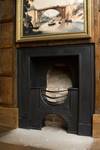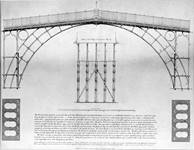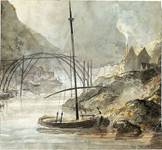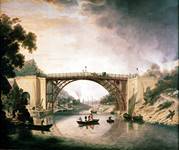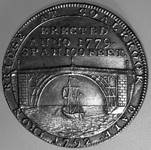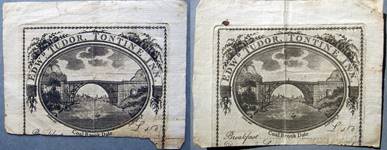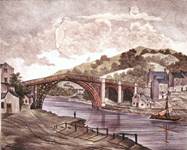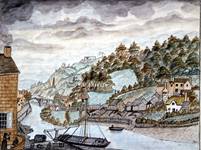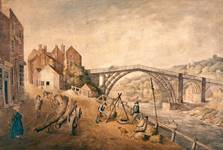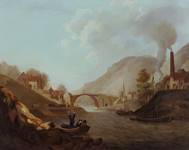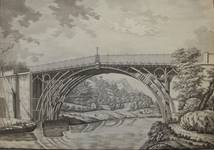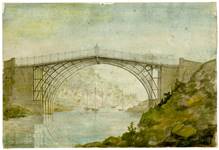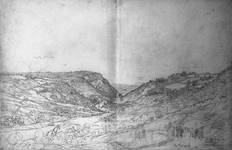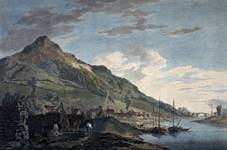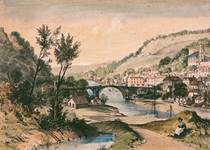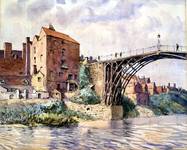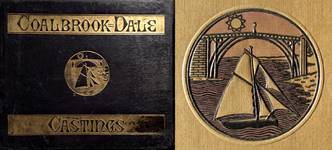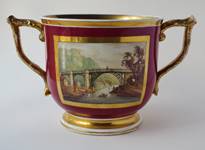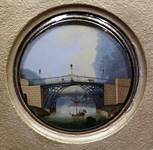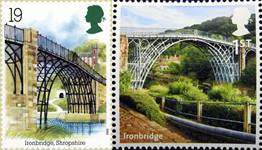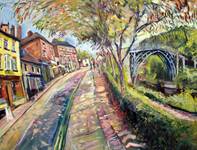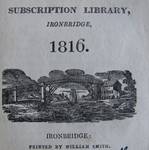A View of the Iron Bridge
In 1979, as part of the Iron Bridge bi-centenary celebrations, an exhibition called ‘A View from the Iron Bridge’ was held at the Royal Academy. An accompanying book of the same name, compiled by Stuart Smith, was published by the Ironbridge Gorge Museum Trust. This book continues to be a useful reference for anyone interested in images of the Iron Bridge, as well as numerous other prints and paintings recording the changing face of the Shropshire landscape during the Industrial Revolution.
This online exhibition features just some of the images of the Iron Bridge from the 1979 exhibition, as well as some more recent finds and acquisitions, to bring the resource up to date.
A view FROM the Iron bridge
oil on canvas, William Williams (active 1758–1797), 1780.
IGMT 1992.12918
In October 1780, Abraham Darby III paid Williams 10 guineas for this charming view of the Iron Bridge. In a boat there are two ladies in their fine hats and an equally elegant gentleman who appears to be pointing out some detail of the bridge to them, while a boatman controls the vessel. In the distance can be seen a number of trows and the industriousness of others in the painting emphasises the leisurely life which the gentry in the boat appear to lead.
VIEW OF THE BRIDGE UNDER CONSTRUCTION
Watercolour, Elias Martin (1739-1818), painted Summer 1779.
Copyright and Courtesy of Skandia, Stockholm
This small watercolour is the only known image of the Iron Bridge under construction. It shows that a simple scaffold was used to construct the bridge. The painting hangs in a restored house in Old Stockholm at Salviigrand No. 1, a private apartment owned by the Skandia Company. The accurate representation of a trow in the foreground lends credence to the observation of the bridge work in the background, and in 2001 a half-scale model of the Iron Bridge was successfully constructed in this way across the canal at Blists Hill for the BBC TV ‘Timewatch’ programme.
a VIEW OF THE cast iron BRIDGE over the severn, at coalbrook dale in phroposhire [sic]
Preparatory pen, ink and wash drawing, Edward Edgcombe (1756-1822), 1782.
2015.147
This drawing is significant due to its very early date of 1782 and also because it was widely reproduced in engravings of 1782 and 1786. Research suggests that prints of the original picture were highly prized and collected by such historical figures as King George III and Thomas Jefferson. The drawing was made by Edward Edgcombe (1756-1822), an architect who moved to Ellesmere in Shropshire. Elements of the drawing, such as the bridge itself, appear to have been drawn in situ by the banks of the River Severn, whilst other aspects may have been completed in the artist’s studio. Records show that Thomas Jefferson, whilst attached to the Court of Louis XVI, bought several images of the Iron Bridge during a visit to London in spring 1786. Jefferson was American Minister to the Court of Louis XVI at Versailles, a post he held from March 1785 to September 1789. His London visit lasted from 12th March to 26th April 1786. He purchased the Edgcombe aquatint, which he later displayed in the Dining Room at Monticello. Five years later he would become America’s third President.
the iron bridge cast at COALBROOKDALE
Engraving, William Ellis (1747-1810) after Michael Angelo Rooker, 1782.
1972.75
This engraving was published by James Phillips, who was a fellow Quaker and printer. His works were just five minutes away from Abraham Darby’s London foundry. Sold at 13 shillings, the engineering drawing was given free to those who bought another engraving by Ellis after Rooker.
COALBROOKDALE trade token, 1792 view of the iron bridge with a trow passing beneath. inscribed above the bridge, 'erected anno 1779 span 100 feet'. legend 'iron bridge at coalbrook dale 1792'
1997.3525
These tokens were struck after the death of Abraham Darby III in 1789, at a time when the affairs of the Coalbrookdale Company were largely controlled by the Quaker ironmaster Richard Reynolds and his son William. The Iron Bridge was built over the River Severn between 1777 and 1781. The iron ribs were put into place in the summer of 1779, which is the year generally quoted as the date of the erection of the bridge. Its construction was due largely to Abraham Darby III, and the Reynolds family had little connection with the project until after its completion.
Billheads
1790s
IGMT 2013.287
Tops of billheads issued by Edward Tudor, of the Tontine Inn, Coal Brook Dale (now Ironbridge), including an oval engraving of the Iron Bridge drawn by Dukes and engraved by Lockington.
the irON BRIDGE near COALBROOKDALE
Hand-coloured lithograph, William Westwood, 1835.
1973.37.1
Westwood produced four views of the area around Coalbrookdale. He drew from nature and engraved on stone, and hand-coloured the resulting lithographs. This is a downstream view of the bridge from the north bank of the Severn, with Benthall Edge in the background.
VIEW from THE severn warehouse
Pen, ink and watercolour, unkown artist, c.1830.
1976.110
This amateur sketch viewed from the site of the Severn Warehouse (the Museum of the Gorge), indicates some of the activity which must have taken place around this busy riverside wharf. In the foreground is a large crane used for loading the Severn trows, an empty one of which is tied up alongside the wharf. The wharf is served by various plateways, together with two waggons, one flat-bedded and the other covered with canvas. On the horizon can be seen an engine house and a gin-pit. Across the river from the warehouse is Bower Yard, with a trow under construction and sections of timber set out on the bank. One interesting feature is the presence of a female figure in the bottom left corner, standing outside the Swan Inn and holding a pint of beer in one hand and smoking a pipe. She is probably the inn-keeper. The picture was painted after 1824 as the Iron Bridge has two cast-iron side arches.
IRONBRIDGE
Watercolour, James Fidlor (1767-1845), 1837.
1978.73
A downstream view of the Bridge, looking along The Wharfage. A heavily laden cart ascends Tontine Hill, while to the right, three men weigh wool.
COALBROOKDALE Shrophire - the first iron bridge built in england, completed 1779 and the iron works founded by abraham darby 1709
Oil on canvas, George Robertson (1724-1788), 1788.
1978.82
Robertson painted a set of six views of the Coalbrookdale area which were published as engravings in February 1788 by Josiah Boydell. All but one of the original paintings are now lost, although the engravings made from them are well known. Robertson was conscious of the great contrast between the romantic beauty of the area and the sublime horrors of the industry within it. He was born in Dorrington near Shrewsbury.
IRON BRIDGE COALBROOK DALE Aug 16 1785
Watercolour, unknown artist, 1785.
2016.282
This recently discovered image carries very few clues as to its origins, but 'Iron bridge Coalbrook dale / Aug 16 1785' is handwritten in pencil on the reverse. Research on the watercolour is currently ongoing.
The IRON BRIDGE, COALBROOKDALE, from the madeley side
Engraving, James Fittler (1758-1835) after George Robertson (1724-1788), 1788.
CBD59.85.1
In this engraving, Robertson is unconcerned with producing the kind of purely pictorial account of the bridge that can be seen in other artists’ work. He shows the bridge, placed right of centre in the composition, surrounded by towering slopes of hanging woods. The figures in the foreground are dwarfed into insignificance by the magnificence of the scenery in which they stand. Unlike most pictorial accounts of the bridge which show it in full daylight, here it is shown with only the left abutment in full light. This and the brightness of the craggy peak above it contrast sharply with the dark foreground and the shaded slopes to create a very real sense of the romantic beauty of the area.
THE IRON BRIDGE near COALBROOKDALE
Pencil, Joseph Farington RA (1747-1821), 1789.
CBD59.129
Inscribed ‘The Iron Bridge near / Coalbrook Dale and / Country Surrounding’ and ‘Sept. 25 – 1789’. Annotated, left to right: ‘Bentley furnace; Green; Lloyds; Bedlam Furnace; Stratton Hill; Lincoln Hill.’
This sketch shows the houses clustered around the riverside at Jackfield and the Calcutts and the beginnings of the settlement of Ironbridge. By this date there appeared to be a large number of buildings around the bottom of Lincoln Hill in the area now known as Hodge Bower. On the extreme left of the picture are a group of buildings and a kiln which are probably the Jackfield Potworks which produced the familiar black-glazed earthenware.
VIEW OF Lincoln Hill, with THE IRON BRIDGE in the distance, taken from the side of the river SEVERN
Hand-coloured engraving, James Fittler (1758-1835) after George Robertson (1724-1788), 1788.
SS/MT35 - Shropshire Star Morley Tonkin Collection
This view shows the stacking and loading of coal into Severn trows prior to transport down river. The area shown in the foreground is the Meadow Wharf at the foot of the Dale. Nailers’ Row, houses leased by the Coalbrookdale Company in 1733, is clearly visible. It stood on the present car park adjacent to the former Severn Warehouse, now the Museum of the Gorge.
IRONBRIDGE
Hand-coloured lithograph, John Cox Bayliss, 1844.
SS/MT36 - Shropshire Star Morley Tonkin Collection
A view of Ironbridge from the Broseley Road, looking upstream to the Bridge. The Severn Warehouse (now the Museum of the Gorge) can be seen in the distance and the church is prominent in the top right corner. The original sketch was drawn in 1839 and was lithographed as part of a set entitled ‘Views of Shropshire’.
VIEW OF THE IRON BRIDGE, and bates and hunt chemist shop
Watercolour, Vera Louise Temple (1897-1955), 1935.
1976.28
Vera Louise Temple was the youngest daughter of Charles Henry Temple, the chief designer at the Maw & Co. tile works in the late 19th century. From January 1936 until August 1955 she was Senior Mistress at the Coalbrookdale High School. The buildings shown next to the bridge were demolished in 1946.
coalbrookdale company illustrated catalogue of 1875 featuring the iron bridge emblem
In the 18th century, the Coalbrookdale Company is believed to have advertised its wares mainly by means of travellers attending local markets, possibly taking samples with them to show to potential customers. It was not until the 19th century that advances in printing technology allowed the Company to start producing illustrated catalogues, the first ones appearing in the late 1830s or early 1840s. They reached their zenith with the magnificent catalogue produced in 1875, which consisted of two substantial volumes totalling over one thousand pages. Some products, such as gates and railings, fireplaces or kitchen ranges, were available with literally hundreds of different designs to choose from. Catalogues were distributed to ironmongers’ shops, and remained the property of the Coalbrookdale Company, to be returned when new ones were issued. This may explain why so few now exist.
2-handled loving cup
Coalport China Company, 1824.
1982.3157
After its completion, numerous tourists, writers and painters were attracted to the Gorge by the Iron Bridge. Alongside the oil paintings and engravings of the bridge, trade tokens, tankards, pottery and even fire grates all featured the new marvel.
VIEW OF the SEVERN
Oil on convex glass, c.1800.
CBD59.8
The ship on the river and bridge itself are painted on the inside of a curved sheet of glass, and the background of the river beyond the bridge, the hills and houses are painted on paper behind the glass, giving a three-dimensional picture.
Postage stamps featuring THE IRON BRIDGE
1989 & 2011.
1994.762 & 2011.411
The Iron Bridge has featured on two postage stamps. The first was issued on 4 July 1989, and was one of a set of four stamps celebrating Industrial Archaeology. The second, issued on 13 October 2011, was part of a set commemorating landmarks in alphabetical order. A-L included Ironbridge. The set M-Z were issued in April 2012.
THE IRON BRIDGE, as seen from tontine hill, looking up the road towards the tontine and market square
Oil on canvas, Robert Pointon (1982-).
2013.212
In 1986, when Ironbridge was originally designated a World Heritage site, the Weston Park Foundation was formed. In 2011, the Foundation celebrated its Silver Jubilee with an exhibition of pictures by living artists, including Rob Pointon who had recently added to his growing reputation by winning the Halls Fine Art Open Competition. One person who saw this painting stated they were ‘…intrigued and delighted by his fresh approach to the Iron Bridge, created in vibrant colour…’
IRONBRIDGE subscription library catalogue title page
Engraving, 1816.
2000.1146
This engraving shows the temporary wooden arches on the south side of the river. The same image first appeared as the title page vignette in a book called ‘The Leisure Hour Improved; or Moral Miscellanies in Prose and Verse, Original and Selected’ by Robert Barnard, published by William Smith, Ironbridge, 1809. William Smith is recorded in Pigot’s Directory of 1822-3 as ‘Bookseller & Printer, Iron-bridge’, and in the 1828-9 edition as ‘Bookseller, Stationer and Printer, Iron-bridge’, and in that edition also as ‘Postmaster’ for Ironbridge.
fireplace with IRON BRIDGE motif
Cast iron, Coalbrookdale Company, c.1781.
CBD59.62
There are two known versions of this fireplace, usually cast iron with a semi-circular fire basket with three front fire bars. The ash hole is a matching semi-circle, around which is the image of the Iron Bridge moulded in relief. There are different inscriptions around the fire holes on the fireplaces; the one type has inscribed in scrolls above the bridge ‘Plan of the Ironbridge at Coalbrook Dale’, whilst the other has ‘A View of the Cast Iron Bridge over the Severn’ inscribed in scrolls on either side of the fire basket. The former product is usually marked Coalbrookdale, whereas the other is usually stamped Carron.

